There’s nothing quite like the thought of starting a new chapter in New Zealand with your beloved pet by your side. Whether you’re moving back home to family or relocating for work, you can bring your pet to New Zealand from Australia.
Although the process isn’t something you can organise overnight, it can be a smooth journey with the right preparation. This ensures your pet gets to share in the new experiences, sights, and smells of life across the Tasman.
Like Australia, New Zealand has some of the world’s strictest biosecurity laws. That means there is a specific process you must follow, even if you are only travelling across the ditch.
We’ll walk you through what you need to know to bring your pet from Australia to New Zealand, from initial eligibility checks and pre-travel preparations to the application process and more.
Planning helps make the journey safe, smooth and stress-free for both you and your pet.
Initial Considerations and Eligibility
Before you start booking flights or gathering paperwork, confirm whether your pet is eligible to travel from Australia to New Zealand. The Ministry for Primary Industries (MPI) sets restrictions on which animals can enter.
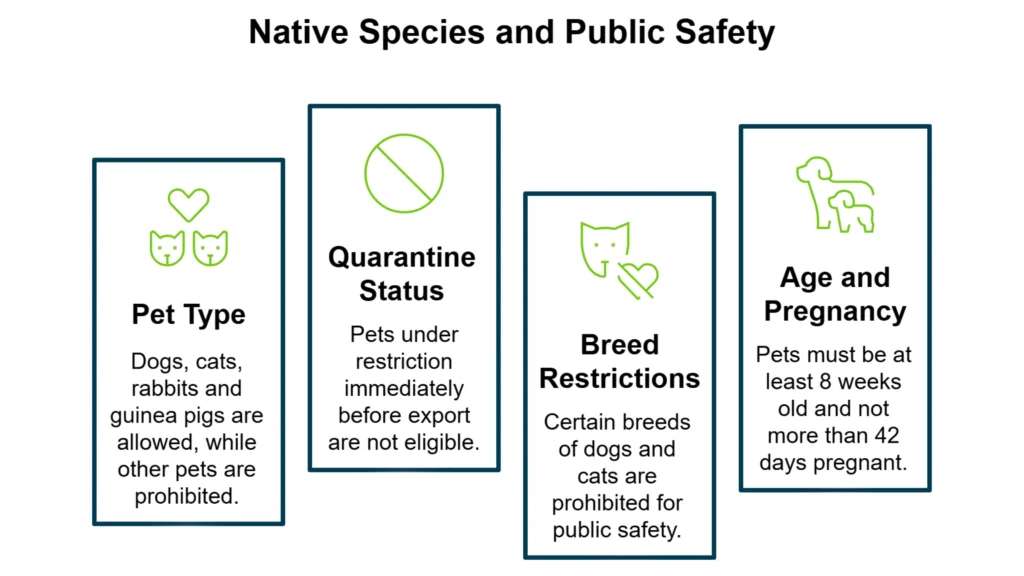
Which Pets Are Allowed?
For most travellers from Australia, the process will mainly apply to dogs and cats, the most popular pets to transport. Other types of pets, such as rabbits and guinea pigs, can travel from Australia to New Zealand.
But live birds are not permitted entry. Snakes and other reptiles are only allowed entry for zoos, while mice and rats are prohibited (except for laboratory use).
Quarantine Restrictions
Has your dog or cat been under any quarantine restriction immediately before export? If so, they are not eligible for entry into New Zealand.
Breed Restrictions and Prohibited Breeds
New Zealand has a ban on the import of certain dog/cat breeds and types, which are considered a public safety risk. If your dog belongs entirely or predominantly to one or more of these breeds, they can’t enter New Zealand.
- American Pit Bull Terrier
- Brazilian Fila
- Dogo Argentino
- Japanese Tosa
- Perro de Presa Canario
No hybrids (offspring of dogs or cats crossed with another species) are eligible for importation, except Bengal cats.
Documentation showing 5 generations of domestic ancestry must be provided for Bengal cats.
Age and Pregnancy Requirements
Dogs and cats must be at least 8 weeks old and weaned to travel to New Zealand. This ensures they are mature enough to get vaccinations and can safely handle the stress of air travel. Puppies and kittens younger than this will not meet MPI’s import standards.
Additionally, your dog or cat can’t be more than 42 days pregnant at the time of departure. Pets more than 42 days pregnant are not eligible for export to New Zealand.
Pre-Travel Preparations (At Least 3 Months Before)
When it comes to moving your pet from Australia to New Zealand, early preparation isn’t only helpful but also essential.
Many of the requirements take weeks or even months to complete. Leaving them until the last minute can lead to costly delays or, worse, denied entry.
Start at least three months in advance.
This gives you plenty of time to meet MPI’s strict standards while keeping the process as stress-free as possible for both you and your pet.
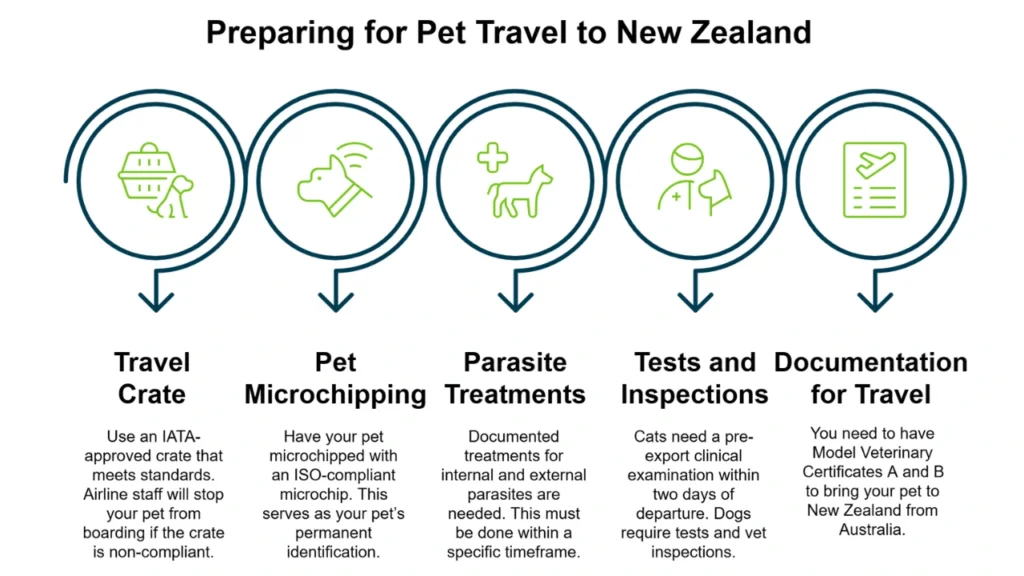
Choosing a Travel Crate
Your pet must travel in an IATA-approved crate that meets international airline standards. Airline staff will stop your cat or dog from boarding the plane if you use a non-compliant crate.
An airline-approved crate is:
- Made of sturdy, rigid plastic or wood (soft-sided carriers are not permitted for cargo travel)
- Large enough for your pet to stand, turn around, sit and lie down comfortably
- Safe and secure (with non-slip fasteners and a locking door)
- Well-ventilated on all four sides
To choose the right size, measure your pet’s:
- Length from nose to tail
- Height from the floor to the top of the head
- Width at the widest point
The crate must:
- Be clean, dry and free of pests
- Only have stable bedding – straw or hay bedding is not permitted
Adding comfort items can make the crate less stressful for your pet. But anything that travels in the crate with your dog or cat will be destroyed on arrival in New Zealand (such as bedding or clothing).
Dogtainers helps you choose the best crate for your pet, and our experts are available to answer any questions you may have.
Microchipping
If you haven’t already, have your dog or cat microchipped with an ISO-compliant microchip. This tiny device, implanted under the skin, serves as your pet’s permanent identification and is required for all imported cats and dogs.
The vet should scan and check the microchip if your pet already has one. As the microchip number must be recorded on all documents, it must work properly.
The microchip must also be scanned and verified at every stage of the process — from veterinary visits to border inspection — so it’s important to ensure it’s functioning correctly.
Internal and External Parasite Treatments
New Zealand’s biosecurity laws are among the strictest in the world, and parasite control is taken seriously. Your pet will need documented treatments for internal and external parasites within a specific timeframe before travel.
These treatments must be carried out by an MPI-approved veterinarian and recorded accurately on your pet’s health certificate.
Treatments for Cats and Dogs
Your cat or dog must be treated twice for external parasites.
- The first treatment should be administered within 30 days before flying
- And at least two weeks before the second treatment
- Which is given within the two days before departure to New Zealand
The external parasite treatment must be effective against fleas and ticks.
Not all brands/treatments are accepted. For instance, with an oral treatment, the parasite has to bite your pet before it dies, which can still transmit diseases. So, a spot-on treatment generally must be used.
Your cat or dog must be treated twice for internal parasites.
- The first treatment should be administered within 30 days before flying
- And at least two weeks before the second treatment
- Which is given within the four days before departure to New Zealand
Internal parasite treatment must be effective against nematodes and cestodes.
Tests and Vet Inspections
For cats, a vet must perform a final pre-export clinical examination within two days before departure. Your cat must be free of evidence of external parasites and clinical signs of infectious and contagious disease.
For dogs, the process is a little different because they require tests and vet inspections.
Canine heartworm (Dirofilaria immitis) – (ELISA) enzyme-linked immunosorbent assay test:
- If six months or older when flying, your dog must have a heartworm test in the 30 days before departure
- All dogs must be treated with a product registered for the prevention of heartworm four days before flying
- Or be up-to-date with a sustained-release injection registered for heartworm prevention
Babesia canis and Babesia gibsoni – (IFAT) immunofluorescence antibody test or (ELISA) enzyme-linked immunosorbent assay test:
- Your dog must have a negative result in the 16 days before departure
- If using a PCR test, your dog must have negative results on two samples collected 30 – 37 days apart
- With the second sample collected in the 16 days before departure
IMPORTANT:
- The Babesia canis test is only required if your dog has ever travelled to or resided in South Africa.
- Dogs diagnosed with Babesia gibsoni are not eligible to come to New Zealand, regardless of treatment.
Canine transmissible venereal tumour (CTVT):
Entire dogs are subjected to an examination of the external genitalia by a vet within two days before flying to New Zealand.
A vet must perform a final pre-export clinical examination within two days before flying. Your dog must be free of evidence of external parasites and clinical signs of infectious and contagious disease.
NOTE:
- We recommend not starting treatments/tests until your flight date is secured or discussed with a pet transport company.
- Because treatments must be repeated if they’re started too early, which ends up costing you more money.
Documentation
To bring your pet to New Zealand from Australia, you need to have Model Veterinary Certificates A and B. Generally, once your vet has completed treatments, tests and inspections:
- They prepare Model Veterinary Certificates A and B
- An official government veterinarian signs, dates and endorses the documents
To get the certificates for your cat or dog, you must declare that they:
- Will be more than 8 weeks of age at the date of departure
- Will not be more than 42 days pregnant
- Has not been under any quarantine restriction immediately before departure
For at least 21 days before shipment, your dog or cat:
- Was not kept in a place where cats or dogs were showing clinical signs of infectious respiratory disease
- Showed no clinical signs of infectious respiratory disease
Dogtainers helps you every step of the way when preparing your pet for transport.
Pet Transport from Australia to New Zealand
All of the pre-travel preparations lead up to the big day when your pet travels with you from Australia to New Zealand. Here’s what to expect in the days before your departure and upon your arrival.
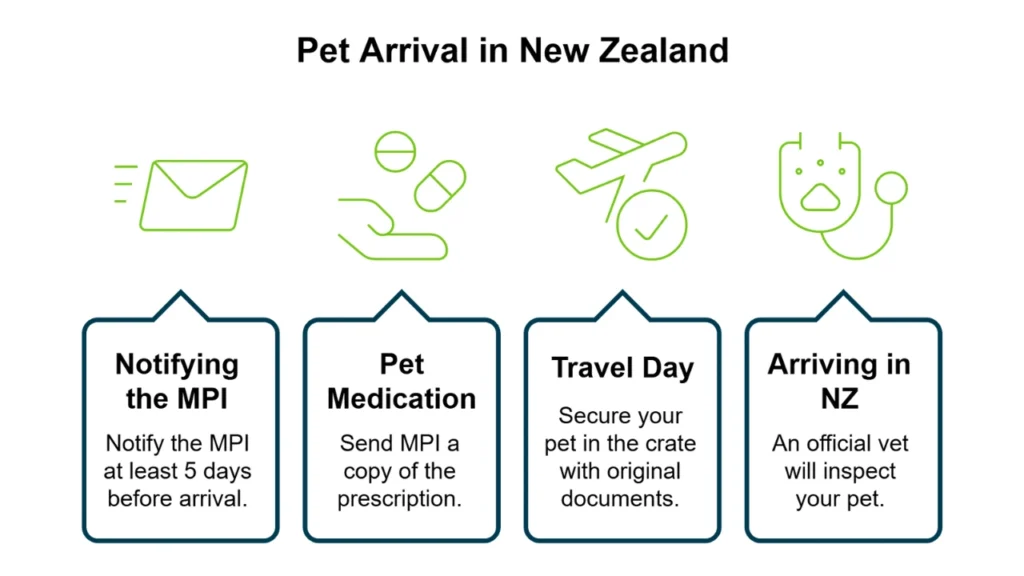
Notifying the MPI
At least five days before your dog or cat arrives in New Zealand, you must notify the Ministry for Primary Industries. You can do this through a form or email (we can help).
Travelling with Medication
Does your dog or cat take medication? You must send MPI a copy of the prescription before or when your pet arrives in New Zealand. If the veterinary medicine is travelling with your pet, you must complete a Declaration of Medicines form.
Attach the declaration and a copy of the prescription to the documents travelling with your pet. Generally, MPI will give clearance for up to a three-month supply.
Travel Day
Your dog or cat must be secured in the sealed crate on the day of travel. They must travel with the following:
- MPI import permit (if applicable)
- The original Model Veterinary Certificate A signed, endorsed and dated
- The original Model Veterinary Certificate B signed, endorsed and dated
- Original laboratory reports or copies endorsed by a vet
- If your pet has medication, a copy of the prescription and declaration
Arriving in New Zealand
On arrival in New Zealand, an official vet will inspect your cat or dog. If all requirements are met, your pet will be granted entry to New Zealand.
If the vet discovers fleas or ticks during the inspection, your cat or dog will be sent to a quarantine facility for further testing and treatment (at your expense).
If you bring a dog to New Zealand, you must register it with your local council.
Bringing Your Pet to New Zealand from Australia with Dogtainers
Moving to New Zealand from Australia with your pet doesn’t have to be stressful. The experts at Dogtainers help you every step of the way.
From advising you on entry requirements to arranging vet visits, we can guide you through everything. You don’t have to go through the process alone.
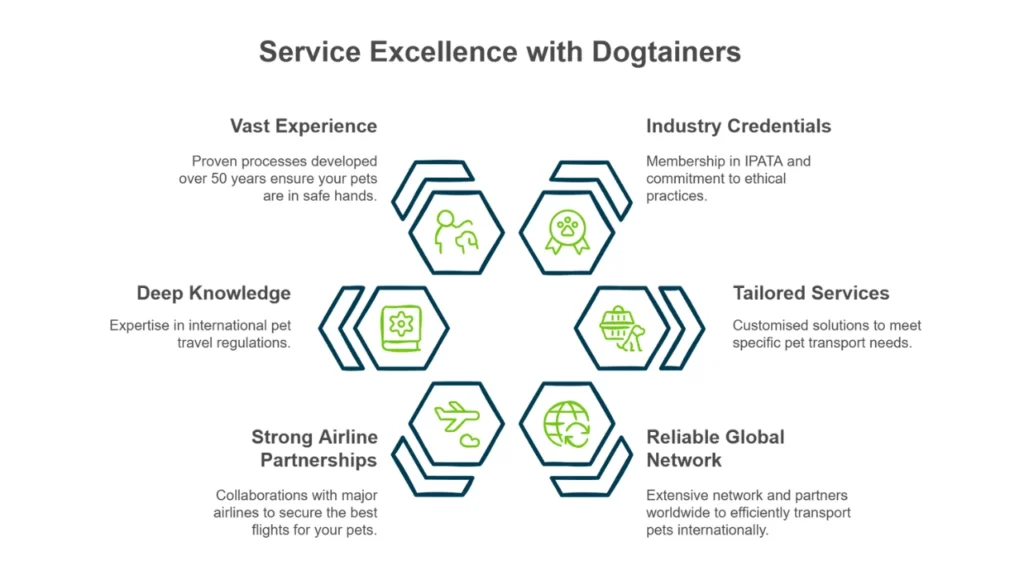
Our experts have been helping pet owners like you with international pet transport for over 50 years. We’re Australia’s oldest and most reliable pet transport company with:
- Vast experience
- Industry credentials
- Tailored services
- Reliable global networks
- Strong airline partnerships
- Deep regulatory knowledge
Conclusion
Moving with your pet from Australia to New Zealand takes careful preparation. But the process doesn’t have to be overwhelming.
Travelling with your pet can be as stress-free as possible with the right planning and expert help.
The main points to consider are pet eligibility, choosing a crate, microchipping, treatments, tests, inspections and required documents.
For bringing your pet to New Zealand from Australia, we recommend starting the process at least three months before departure. This gives you plenty of time to organise your pet’s transport.
We’re here to make your international pet travel experience safe, smooth, and stress-free.
Get your quote today for relocating your pet to New Zealand from Australia.

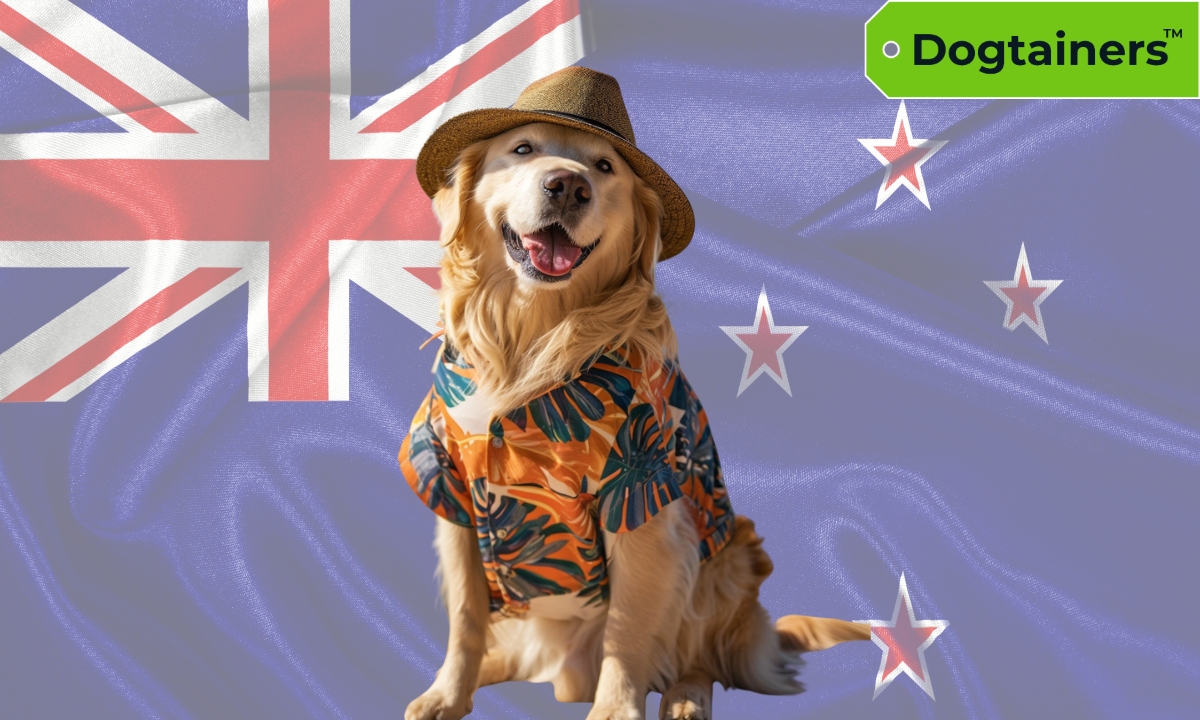
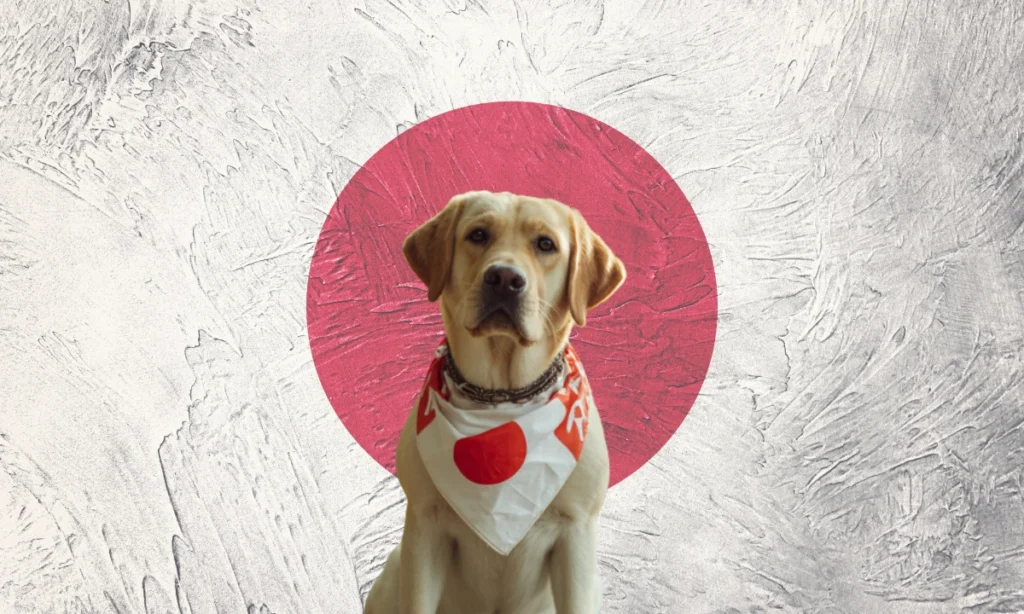
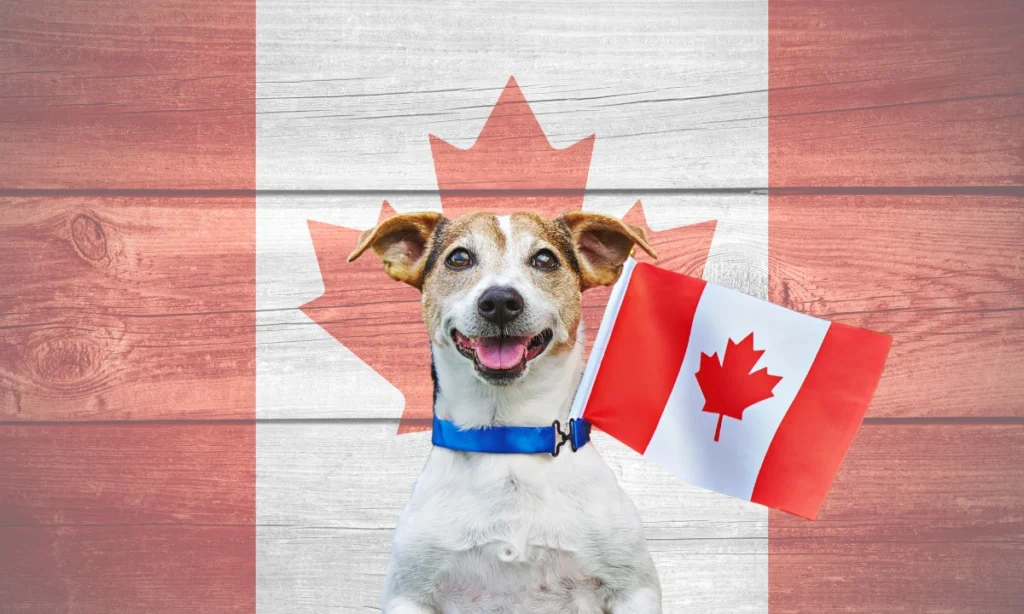

Share this article